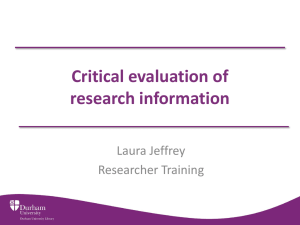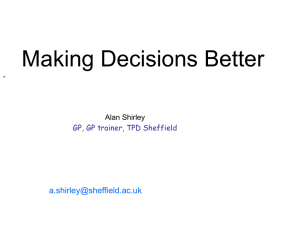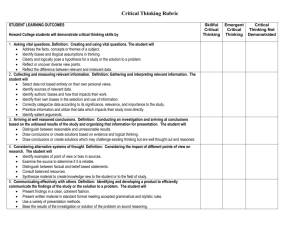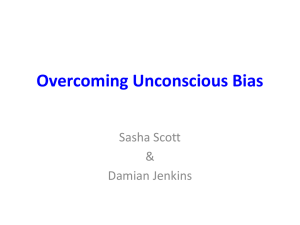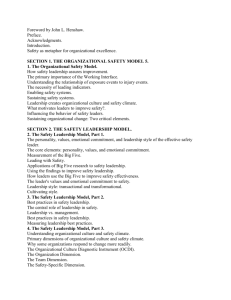BIASES AND DEFENSE MECHANISMS AS LIMITS TO LEARNING
advertisement
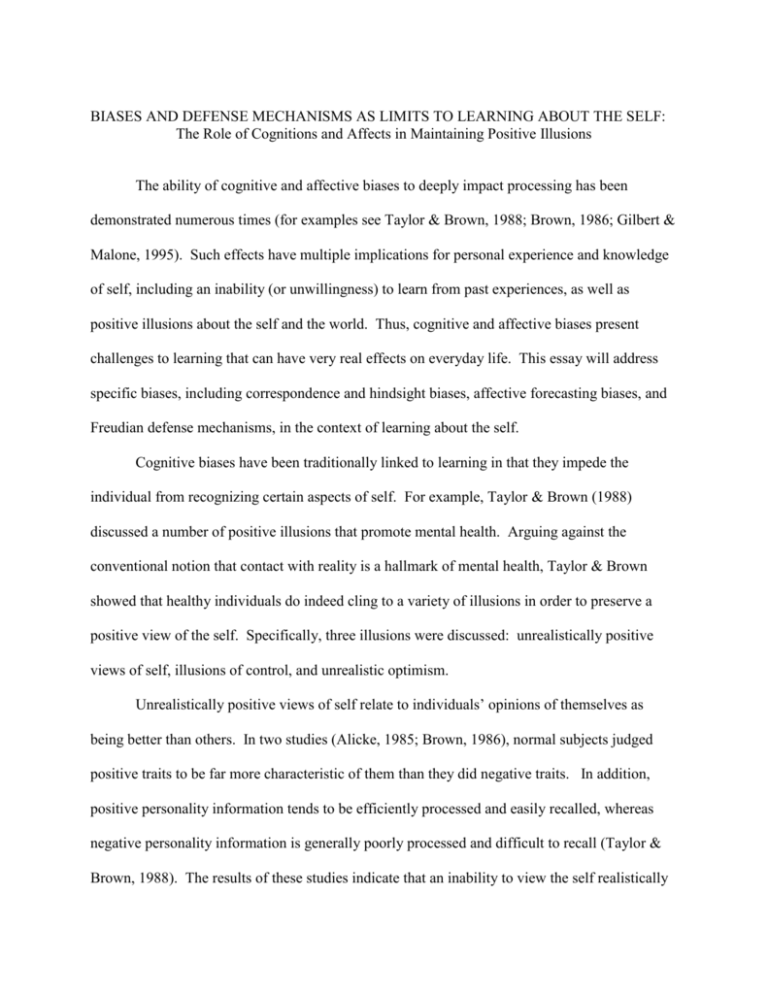
BIASES AND DEFENSE MECHANISMS AS LIMITS TO LEARNING ABOUT THE SELF: The Role of Cognitions and Affects in Maintaining Positive Illusions The ability of cognitive and affective biases to deeply impact processing has been demonstrated numerous times (for examples see Taylor & Brown, 1988; Brown, 1986; Gilbert & Malone, 1995). Such effects have multiple implications for personal experience and knowledge of self, including an inability (or unwillingness) to learn from past experiences, as well as positive illusions about the self and the world. Thus, cognitive and affective biases present challenges to learning that can have very real effects on everyday life. This essay will address specific biases, including correspondence and hindsight biases, affective forecasting biases, and Freudian defense mechanisms, in the context of learning about the self. Cognitive biases have been traditionally linked to learning in that they impede the individual from recognizing certain aspects of self. For example, Taylor & Brown (1988) discussed a number of positive illusions that promote mental health. Arguing against the conventional notion that contact with reality is a hallmark of mental health, Taylor & Brown showed that healthy individuals do indeed cling to a variety of illusions in order to preserve a positive view of the self. Specifically, three illusions were discussed: unrealistically positive views of self, illusions of control, and unrealistic optimism. Unrealistically positive views of self relate to individuals’ opinions of themselves as being better than others. In two studies (Alicke, 1985; Brown, 1986), normal subjects judged positive traits to be far more characteristic of them than they did negative traits. In addition, positive personality information tends to be efficiently processed and easily recalled, whereas negative personality information is generally poorly processed and difficult to recall (Taylor & Brown, 1988). The results of these studies indicate that an inability to view the self realistically stems from a bias toward positive personality information, or, in other words, a limit of learning about the self. Taylor & Brown (1988) also discussed individuals’ tendency to act as if they have control in situations determined by chance, which the authors termed as illusions of control. An example of this can be seen in the fact that most people would rather roll the dice than let someone else roll for them. However, illusions of control go much deeper than that, extending into general distortions that are related to outcome expectancy. Taylor & Brown further discussed people’s tendency to overestimate their responsibility for an expected outcome, suggesting a limit in individuals’ capacity to recognize their own role in bringing about certain outcomes. This limit fosters disillusionment regarding ability and personal responsibility, and allows for the maintenance of a positive sense of self. The last illusion Taylor & Brown’s (1988) study demonstrated is unrealistic optimism related to both the self and the future. Most people believe that the present is better than the past, that the future will be even better (Brickman, Coates, & Janoff-Bulman, 1978), and that their likelihood of experiencing pleasant events is higher than those of their peers (Weinstein, 1980). Most individuals also estimate their chances of experiencing negative events as lower than others. Further, predictions of what will occur tend to correspond closely to what subjects would like to see happen or what is socially desirable rather than what is objectively likely (Taylor & Brown). Unrealistic optimism, especially when combined with unrealistically positive views of self and illusions of control, reveals the ineptitude of the vast majority of people to objectively analyze themselves, their experiences, and the world around them. Another cognitive bias contributing to individuals’ inability to learn about themselves and others is the correspondence bias. This bias refers to the tendency of people to draw inferences about another person’s unique dispositions from behaviors that can be explained by the situation (Gilbert & Malone, 1995). Potential causes for the correspondence bias include a lack of awareness of situational constraints and unrealistic expectations for behavior. This bias in how we view others can lead to several negative consequences for the self. For example, incorrect judgments in the causes of another person’s behavior may cause an individual to respond inappropriately. However, as with other biases, the correspondence bias also has positive implications for the self. Misinterpreting others’ behavior allows people to gain power over the world through a type of wishful thinking (Gilbert & Malone, 1995). Imagining that another person has control over a situation and that their actions are therefore representative of internal dispositions is critical to the maintenance of illusions of control. Thus, in order to preserve our understanding of our world and ourselves as predictable and controllable, it is necessary to believe that people are responsible for their own actions. This limitation has the potential to prevent individuals from learning the causes of their behavior, which can then inhibit the capacity for self-awareness and decision-making. The hindsight bias is another cognitive distortion that provides opportunities for individuals to uphold a sense of control over the world around them. Defined as the tendency for people with outcome knowledge to believe falsely that they would have predicted the reported outcome of an event (Hawkins & Hastie, 1990), the hindsight bias is especially likely to occur when an event has well-defined alternative outcomes (e.g. win-lose). Importantly, the bias is accompanied by the denial that outcome information has influenced the individuals’ judgment that they would have predicted the event. This is evidenced by Fischhoff’s (1975) study demonstrating that subjects were unable to ignore reported outcomes. Therefore, it is nearly impossible to retrospectively analyze our ability to predict the outcome of an event, which can have serious negative consequences for the self, especially in cases where the outcome is unfavorable. Since people tend to give more weight to cues supporting the known outcome (Fischhoff), it is difficult to imagine alternative outcomes to past events. Additionally, outcome information is immediately and automatically integrated into knowledge about events preceding the outcome, which also leads to a limit in our ability to learn from the past. Such an inability to incorporate both possible sides of an outcome has serious implications for our capacity to effect change in our own futures. Information-processing biases present additional acute roadblocks to individuals’ acknowledgment of their own strengths and weaknesses. This is due to people’s tendency to see messages that favor their position as more compelling (Lord, Ross, & Leper, 1979), which may in turn prevent them from seeing better alternatives. Because individuals generally have more information in memory that supports their own position and given that this tendency is especially strong when the person’s own attitude on the topic is robust (Houston & Fazio, 1989), the ability of people to see the weaknesses of their own beliefs and attitudes is therefore seriously constrained. Of course, motivational reasons for such distorted processing preclude our capacity to monitor intrapersonal biases. Information-processing biases generally result from threats to the self, including self-esteem, social status, or a person’s freedom to hold certain beliefs (Houston & Fazio, 1989). These threats must be continuously thwarted in order to maintain positive views of self and world. Processing biases play a large role in this by denying us the opportunity to be fully conscious of our own weaknesses. This is particularly disconcerting when one considers the larger context of cognitive distortions that prevent us from being aware of the causes of our own behavior. Decision-making biases also contribute to general ignorance regarding the self. Because decision-making processes are based on predicted affective responses to potential outcomes (Laham, 2005), an individual’s ability to make choices about the future is inevitably limited due to biased processing regarding past events. As discussed previously, the hindsight bias virtually ensures that past outcomes will be viewed as inevitable, thereby distorting an individual’s awareness of the actual cause of the outcome. Since predicted affective responses tend to be based on past experiences, the decisions people make about the future are necessarily limited by the biased processing of past events. However, biased decision-making processes can have other negative consequences for the self. Choices that are based on predicted affective responses imply that individuals will decide to do things based on what they think will make them happy. While this is not always a bad thing, sometimes difficult decisions must be made. Laham (2005) demonstrated that anxious individuals predicted that they would feel worse about a task such as speaking in public, and subsequently decided to engage in the task less often. These types of anxieties often result in people opting for short-term comfort or gratification over long-term benefits. This also presents serious limitations in individuals’ ability to learn what is best for them. Emotional events are not simply the cause of decision-making biases, but are also understood in an inherently distorted manner. People tend to underestimate counter-regulatory processes that counteract the effects of positive or negative events (Rothermond, Voss, & Dirk, 2008). Thus, these events generally have only short-term consequences on affective-emotional states, despite the fact that most people overestimate the amount of time a single event will effect their emotional state (Wilson, Meyers, & Gilbert, 2001), even in domains in which they have considerable past experience. People tend to predict that negative events will cause greater levels of distress and negative affect than is usually true (Eastwick, Finkel, Krishnamurti, & Loewenstein, 2008), possibly as a result of a tendency to focus only on the emotional event in question when making predictions. This impact bias, or overestimation of the impact of future events on emotional reactions, is marked by both an initial intensity bias (poor estimation of initial emotional reactions) and a decay bias (poor estimation of the rate at which emotional reactions diminish over time). Individuals’ inability to accurately predict the duration of positive or negative emotional outcomes may increase biased decision-making processes, thereby constraining capacity for future change through self-reflection. There are, however, several cognitive and affective processes in place that reduce the possibility for chronic biases in information processing. For example, positive feedback facilitates processing of negative stimuli, whereas negative feedback facilitates processing of positive stimuli (Rothermond, Voss, & Dirk, 2008). Therefore, positive and negative outcomes focus opposite attentional biases, allowing for a more realistic processing of stimuli following the outcome. Rothermond and colleagues argue that this is not just part of coping with past events, but rather it is actually characteristic of goal pursuit and action-regulation, thus allowing individuals to access more accurate knowledge of the self. Other biases impacting self-awareness stem from the difficulty individuals experience recalling emotional states. People generally display poor memory for the intensity or frequency of specific emotions such as anger and sadness (Levine, 1997), positive and negative moods (Thomas & Diener, 1999), and attitudes (Ross, 1989; Ross & Newby-Clark, 1998). Such difficulty in remembering emotional states may be a result of the previously discussed counter- regulatory processes designed to reduce the impact of positive or negative events, and as such are useful in preventing individuals from becoming overwhelmed by certain outcomes. However, affective memory biases present serious challenges and can thus be detrimental to the self to the extent that they restrict one’s ability to learn from past mistakes and successes. Wilson et al. (2001) outlined three conditions necessary to learn from previous experience. Firstly, the mental effort criterion refers to the effort required to compare past experiences with future ones, as opposed to thinking about the future event in isolation. The second, applicability criterion, states that if people do make this effort to consult the past, they will need to decide which experiences are most applicable. Then, even if people recognize which events are applicable and make the effort to think about them, they must be able to recall or accurately reconstruct how they felt. This is clearly difficult in the face of the aforementioned affective biases, and these criteria demonstrate the challenges inherent in learning about the self. The cognitive and affective biases discussed up until this point have come from relatively recent research. However, it is important to recognize traditional Freudian defense mechanisms in the framework of limits of learning about the self. These mechanisms operate unconsciously to deny, falsify, or distort reality (Hall, Lindzey, & Campbell, 1998), and may be characterized as patterns of self-deception that work to maintain overly positive self-perceptions (Baumeister, Dale, & Sommer, 1998). Thus, these mechanisms are almost certainly stumbling blocks between even the most self-aware individual and their own knowledge of self. Because defense mechanisms are part of the process of defending against the threatening implications of events that violate the preferred view of self (Baumeister et al., 1998), they necessarily prevent individuals from knowing, or even becoming aware of, certain aspects of themselves. Firstly, repression is a defense mechanism in which an object-choice that arouses excessive alarm is forced out of consciousness (Hall et al., 1998). An example of this phenomenon occurs when a repressed memory causes an individual not to see something in plain sight. The impact of repression on learning about the self can be severe as it is both difficult to abolish and deeply ingrained. A similarly manifested defense mechanism is that of denial. This distortion varies tremendously in degree as it can, at times, result in an almost psychotic refusal to perceive the physical facts of the environment, while at other times it can simply lead to the common hesitation to accept the implications of an event (Baumeister et al., 1998). Denial and repression both represent defense mechanisms that prevent learning in very clear ways. By removing threatening aspects of reality, they allow individuals to maintain positive illusions about the self and the world that are crucial for healthy mental functioning (Taylor & Brown, 1988). An additional cognitive bias, called reaction formation, consists of converting a socially unacceptable or anxiety-producing impulse into its opposite (Baumeister et al., 1998; Hall et al., 1998). Reaction formation is marked by extravagant showiness; for instance, when hate is replaced by love, the individual may make extreme displays of affection in order to avoid both personal and public realization of the socially unacceptable impulse. While reaction formation was originally associated with sex and aggression, it is now being applied to a wider range of emotions (Baumeister et al., 1998) and its implications for self-awareness are clear in that when one impulse is converted into another (as when hate becomes love), the original emotion may manifest itself in unhealthy ways. Such manifestations thus prevent the realization of the unacceptable impulse by the self and others. Projection is a defense mechanism that involves perceiving others as having traits that one inaccurately believes oneself not to have (Baumeister et al., 1998). This bias is popularly understood as seeing one’s self in others, and has two distinct purposes. The first purpose, substituting a lesser danger for a greater one (Hall et al., 1998), represents people’s need to preserve a positive sense of self, especially in the face of evidence to the contrary. Thus, projection also serves the purpose of allowing an individual to express impulses under the guise of defending against enemies. Evidence of this bias is found in the false consensus effect, first described by Ross, Greene, and House (1977). Defined as overestimating the percentage of other people who share one’s traits, opinions, preferences, or motivations, this effect can have both cognitive and motivational influences (Baumeister et al., 1998). Projection stems from an inability or unwillingness on the part of the individual to accept personality information that threatens positive or stable views of the self, and results in a lack of awareness about one’s own negative personality traits. Next, displacement is a cognitive distortion that refers specifically to altering the target of an impulse (Baumeister et al., 1998), usually because the preferred target is inappropriate. One example of this is when a violent impulse toward one’s father is transformed into hostility toward other male authority figures. This distortion not only effects individuals’ ability to understand the true causes of their actions, but also causes them to reflects biased judgments about the self and others. Displacement therefore represents a limit to learning. Yet another defense mechanism, isolation, involves mental gaps that are created between a threatening cognition and other thoughts and feelings (Baumeister et al., 1998). Isolation serves to minimize the impact of potential threats to the self, which is one of the main purposes of most cognitive and affective biases. Specifically, it allows individuals to reduce the influence of potentially harmful cognitions by keeping them separate from other, more positive, aspects of the self. This provides people with the opportunity to minimize threats to the self by creating related pockets of ignorance. Perhaps the strongest cognitive bias is undoing. This defense mechanism consists of attempts to alter the past in order to make a particular misfortune seemingly disappear from reality (Baumeister et al., 1998). In less severe instances of undoing, people may be unable to control reflections about past events, especially if the retrospection is marked by vivid counterfactual thoughts about alternative outcomes. Thus, undoing represents a cognitive bias that prevents individuals from learning about the self by narrowing one’s focus to include only specific aspects of past events. Obsessing over perceived mistakes and misfortunes reduces the cognitive capacity that is a criterion for learning from them, creating a cycle in which it becomes incredibly difficult for the individual to make positive progress. Freudian defense mechanisms, cognitive biases, and distorted affective processes all limit individuals’ ability to learn about themselves. Although they represent a small minority of the ways in which people psychologically distort the world and knowledge of self to their benefit, they are incredibly common. While individuals without such distortions are able to view themselves more realistically, they are also more likely to be moderately depressed and suffer from low self-esteem (Taylor & Brown, 1988). Evidence regarding the existence and purpose of cognitive and affective biases suggests that they play a key role in maintaining mental health through allowing people to remain ignorant about certain aspects of themselves and their world. Thus, they represent very specific limits in what people are able to learn. WORKS CITED Alicke, M.D. (1985). Global self-evaluation as determined by the desirability and controllability of trait adjectives. Journal of Personality and Social Psychology, 49, 1621-1630. Baumeister, R.F., Dale, K., & Sommer, K.L. (1998). Freudian defense mechanisms and empirical findings in modern social psychology: reaction formation, projection, displacement, undoing, isolation, sublimation, and denial. Journal of Personality, 66. 6. Brickman, P., Coates, D., & Janoff-Bulman, R. (1978). Lottery winners and accident victims: Is happiness relative? Journal of Personality and Social Psychology, 36. 56-71. Brown, J.D. (1986). Evalutions of self and others: Self-enhancement biases in social judgments. Social Congition, 4. 353-376. Eastwck, P.W., Finkel, E.J., Krishnamurti, T., Loewenstein, G. (2008) Mispredicting distress following romantic breakup: revealing the time course of the affective forecasting error. Journal of Experimental Psychology. 44, 800-807. Fischhoff, B. (1976). Attribution theory and judgment under uncertainty. In J.H. Harvey, W.J. Ickes, & R.F. Kidd (Eds.), New directions in attribution research (Vol 1, 421-452). Hillsdale, NJ: Erlbaum. Gilbert, D.T., Malone, P.S. (1995). The correspondence bias. 116. 21-38. Hall, C.S., Lindzey, G., Campbell, J.B. (1998) Theories of Personality. New York: John Wiley & Sons. Hawkins, S.A., & Hastie, R. (1990). Hindsight: Biased judgments of past events after the events are known. Psychological Bulletin, 107, 311-327. Houston, D.A., & Fazio, R.H. (1989). Biased processing as a function of attitude accessibility: Making objective judgments subjectively. Social Cognition, 7. 51-56. Laham, S.M. (2005). Feeling the future: The role of current emotions in affective forecasting. Submitted as thesis to University of New South Wales. Ross, M. (1989). Relation of implicit theories to the contruction of personal histories. Psychological Review, 96, 341-357. Ross, M., & Newby-Clark, I.R. (1998). Construing the past and future. Social Cognition, 16, 133-150. Rothermund, K., Voss, A., Dirk, W. (2008) Counter-regulation in affective attentional biases: A basic mechanism that warrants flexibility in emotion and motivation. Emotion. 8:1. 34-46. Silverman, I. (1964). Self-esteem and differential responsiveness to success and failure. Journal of Abnormal and Social Psychology, 69. 115-119. Taylor, S.E., & Brown, J.D. (1988). Illusion and well-being: A social psychological perspective on mental health. Psychological Bulletin, 103, 193-210. Weinstein, N.D. (1980) Unrealistic optimism about future life events. Journal of Personality and Social Psychology, 39, 806-820. Wilson, T.D., Meyers, J, & Gilbert, D.T. (2001) Lessons from the past: Do people learn from experience that emotional reactions are short-lived? Psychology and Social Psychology Bulletin, 27, 1648-1661.
